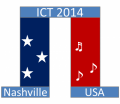Google Search
A5: Nanoscale and low dimensional effects
The use of semiconductor nanowires for thermoelectric power generation and solid state cooling has gained momentum in recent years due to the increase of the thermoelectric figure of merit (ZT) due to a significant decrease of the thermal conductivity by phonon-boundary scattering. Thermal conductivities of crystalline nanowires have reached values comparable to their amorphous counterparts.1,2However, the enhancement of the thermoelectric efficiency due to phonon-boundary scattering still fails to achieve ZT values large enough for a wide use of thermoelectrics. A greater improvement in ZT could be achieved if increases could be made to the Seebeck coefficient (S) [ZT is proportional to S2], but increases in S are generally offset by reductions in electrical conductivity (σ) which could result in a degradation of the thermoelectric power [S2 σ]. Our work is focused on study of the thermoelectric characteristics of band-gap engineered high-electron-mobility nanowires. We synthesized triangular shape Nitrogen-face GaN, GaN/AlGaN core/shell, and GaN/AlGaN/GaN core/shell/outer-shell nanowires with unintentionally doped GaN core. We placed individual nanowires in our thermoelectric characterization platform by the use of nanomanipulation and study the thermoelectric properties from 25 K to 310 K. We observed a large enhancement of S for the core-shell GaN/AlGaN NW due to the high mobility of the electron gas, but the electrical conductivity is dominated by the GaN. Decoupled between S and σ is observed. The formation of a hole gas in the GaN/AlGaN/GaN core/shell/outer-shell nanowire corroborates the previous funding. This means that for materials or devices high electrical conductivity and high electron mobility can be simultaneously achieved and thus get an optimized ZT value.
(1) Hochbaum, A. I. et al. Nature 2008, 451, 163-167.
(2) Martinez, J. A. et al. J Appl Phys 2011, 110, 074317.
This work was performed, in part, at the Center for Integrated Nanotechnologies, an Office of Science User Facility operated for the U.S. Department of Energy (DOE) Office of Science by Los Alamos National Laboratory (Contract DE-AC52-06NA25396) and Sandia National Laboratories (Contract DE-AC04-94AL85000).
